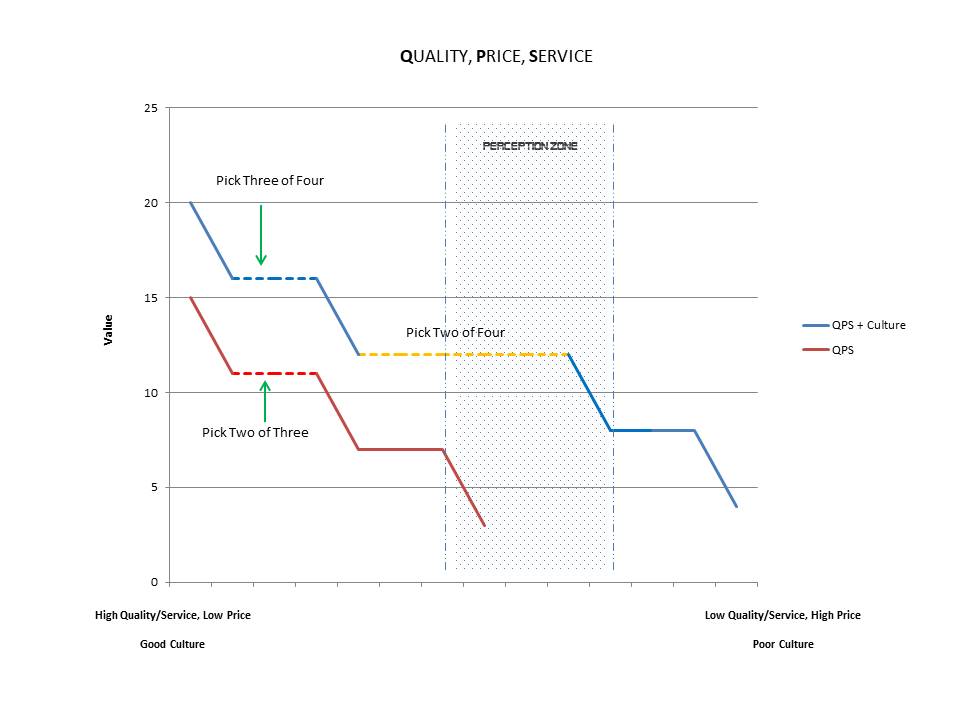Finding the Right Answer
There is another dimension often overlooked. Culture. Great company culture, not as defined by you and your employees but as defined by your customers, business partners, and competitors.
As business leaders, we contemplate where we should focus our organization’s efforts. What is the best use of our resources (people energy, time, and money)? All are limited and once utilized, are gone forever. How do we determine the best return on those investments?
When researching an external investment, say software for instance, you would want to identify the optimal mix of quality, price and service (QPS). There is an old adage…’Pick Two’. If you want good product and good service, you will pay a premium. If you desire good service and low price, you sacrifice quality, and so on. Anyone that says they offer all three are either losing their ass or lying (per the old adage).
There is another dimension often overlooked. Culture. Great company culture, not as defined by you and your employees but as defined by your customers, business partners, and competitors.
A definition of culture will help determine if that is where we need to invest. When looking externally, a great culture is defined by how well others treat you, how well others treat others, or how well others treat themselves.
Using that definition, I performed a very rudimentary analysis that added culture to the QPS equation with the hypothesis that ‘culture doesn’t matter’. The graph below illustrates the output of those matrices. When assigning the same value to each category (5 = Good and 1 = Poor) it illustrates that simply adding in culture does not necessarily move the needle, however adding in good culture pumps up the value.
Also discovered is the shaded area, the Perception Zone, where many people end up. They evaluate something only on the merits of QPS and do not take into consideration, culture. Culture exists, but if you do not account for it, you may end up with a distorted view of your investment and returns.
What happens is that with the QPS model, you pick two of three and if you consciously use the QPS + Culture model, you pick three of four. You end up in the perception zone if you disregard culture because it exists whether you recognize it as critical or not, whereby artificially inflating the value (your perception of the value).
When you do your external search for the solution that can help you gain a competitive advantage, or to improve productivity through automation, find an organization with people who actually care about you as much or more than they do about themselves. People can talk about partnerships and relationships all day long, but what really matters is how they behave.

Now, take the external evaluation and apply it internally. We offer good products and good service at a reasonable price, but what is our culture like? Do we invest in more product features, more service people, more operational efficiency, or in our culture?
Product features have economies of scale along with the risk of flat or diminishing returns over time. More people that operate more efficiently can provide a better service, but at what cost?
It is about people and it always will be. As a company, an organization of people, you can only control how you treat yourself and how you treat others.
My hypothesis was incorrect, culture does matter.I am not messing with our culture.
#SoftwareOnYOURTerms
Related Posts
Bookmark, Link, Search
Written by: Henry Nelson Today, the HarrisData Payroll for bookmark, link, search is in beta. It will be available to you via public or private cloud soon. We are working to connect the remaining business logic to the bookmark, link, search platform and look forward to providing you the results.
Mashup Enterprise Services
Written by Henry Nelson It is time to take a mashup approach to ERP systems. A modern ERP architecture based on enterprise services can make it happen. The use of mashups in the user interface is common for HTML based applications.
Can you see it?
Written by Tim Dunn, The forest I am looking at doesn’t contain Unicorns. They will not be showing up here anytime soon. I’m ok with that. Because if we keep doing things right, for the right reasons, like we have for the past 45 years, we’ll remain at a healthy and respectful place in the food chain. I can see it.
Multitenancy: Panacea and Problem
Written by: Lane Nelson We believe multitenancy creates cost advantages for ISVs like HarrisData, and intend to leverage multitenancy in whatever forms provide the most value to our customers. However, a religious commitment to multitenancy ahead of real customer requirements is just pandering to investors.
Services as a Service (2/3)
Written by Tim Dunn, "Only buy exceptionally viable products. And if you like the cutting edge, work with a software company that truly puts your interests first".

